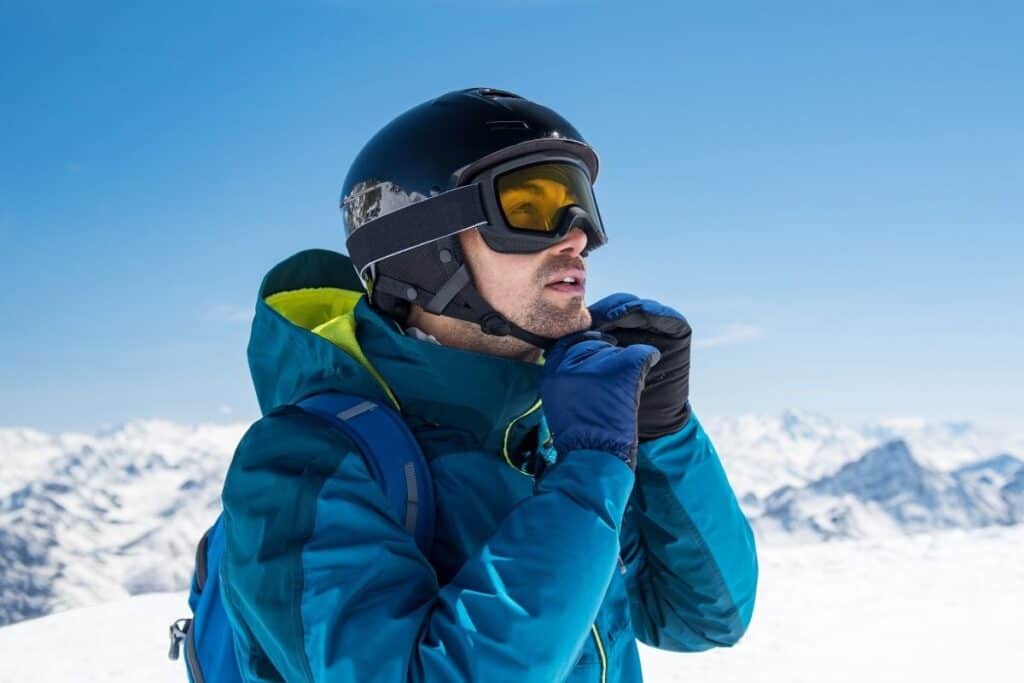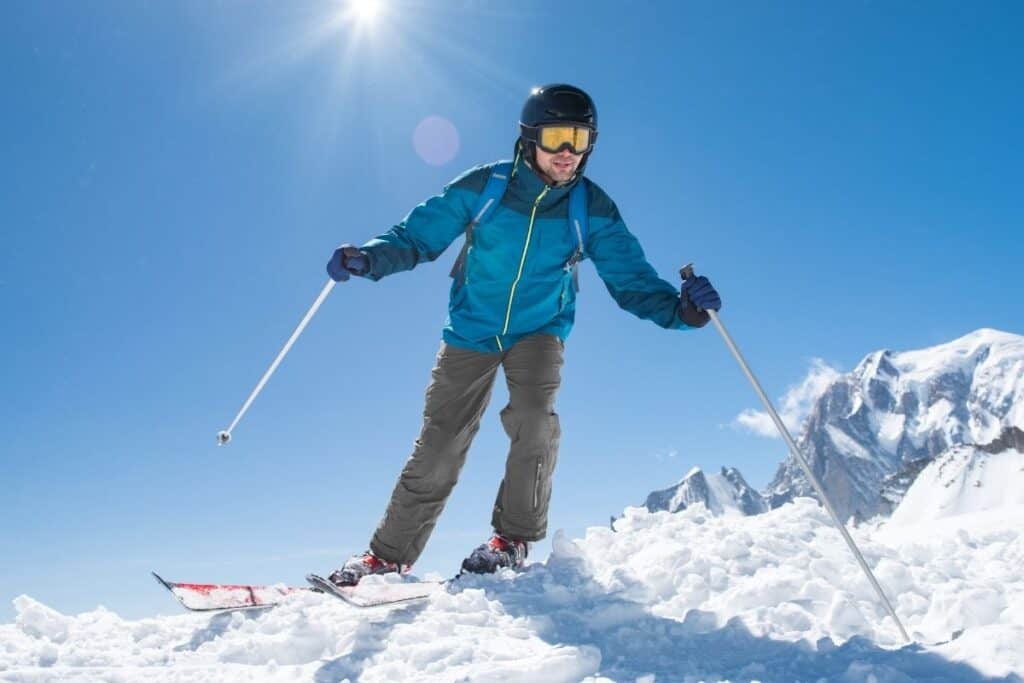
There was a point in my life where I loved the feeling of wind in my hair so much that I would leave my helmet at home on big trips. I would tell myself – I’m experienced enough, I won’t fall. If you feel the same way, you might be wondering, should I wear a helmet skiing? Is it really necessary?
The use of a helmet while skiing is highly recommended given that head injuries are the number one source of death and disability in snow sports. Additional benefits of ski helmets include added warmth and reduced glare.
So if wearing a helmet is so important, why do so many people choose not to wear one? This article will look at some of the reasons people choose not to and discuss why the reasons to wear a helmet outweigh them.
Are Helmets Required to Ski?
Whether or not helmets are required to ski depends on which resort you are going to. While many resorts do have requirements around helmet usage, not all do.
For example, in many Colorado resorts skiers are generally not required to wear helmets. With so much freedom, skiers often choose to feel the wind in their hair instead of staying stuffed up in a hot helmet.
It’s not hard to see why skiers choose to skip the helmet. For one, they can get hot and feel constraining. While they’ve certainly gotten lighter and less obtrusive over the years, they do take some getting used to.
This is especially true if you’ve skied for decades without a helmet!
Now – while helmets may be a temporary nuisance, they absolutely provide a safety benefit.
According to the NCBI, head injuries have a 22% chance of causing unconsciousness or signs of a concussion, which can mean big trouble in the long term. This means that about one out of five head injuries will be severe enough to cause at least temporary health issues.
Head injuries are also the most common cause of death or disability in skiers and snowboarders. For this reason, we can’t recommend not wearing a helmet on the slopes.
Helmets are a cheap, simple way to help protect your noggin!

Pros and Cons of Wearing a Ski Helmet
All of that being said, we’re not going to pretend there aren’t some drawbacks to wearing a helmet. Helmets do get hot and sweaty and can decrease your field of view. Buying the wrong helmet may be ineffective while buying the right one can be expensive.
In the end, we believe that the cost of not wearing a helmet far outweighs any benefits you may receive. Preventing severe head injury should be a skier’s priority over any consideration of mobility or comfort.
Let’s put it this way- you might be uncomfortable in your helmet, but it’s better than being uncomfortable in a hospital bed!
Pros of Ski Helmets
The pros of wearing a helmet come in many forms- most of them having to do with your overall health. Just like riding a bike or snowboarding, skiing involves a risk of head injuries, which can become serious under the right conditions. Helmets can prevent such injuries.
Head injuries are the number one cause of death among skiers. When you hit a tree or a rock with your head, your brain gets smushed up against the inside of your skull, suffering severe trauma.
If you manage to survive the impact, your brain’s ability to communicate with the rest of your body may be irreparably altered. You may become disabled or lose control of your face and limbs.
Keep in mind, hospitals are not cheap in the United States. According to some data, the average US hospital stay will cost just over $10,000, which can be a severe burden if you don’t have health insurance.
Depending on how large they are, hospital bills can follow you around for years… If you get annoyed by student loan payments, imagine tacking on another $20,000 in hospital fees!
When you put the cost of a decent skiing helmet up against these fees, it doesn’t seem so steep. You can often find deals for helmets online, and if all else fails, you could definitely look on apps like Offerup or Mercari for used ones.
Some ski helmets also have visors built right in. If you’re dreading the cost of a pair of goggles but don’t want to get all teary-eyed on a downhill ever again, a good helmet can solve two problems at once.
If you’re thinking about it in terms of overall utility, the facts lean toward buying a helmet. Good helmets will help keep your head warm, shield your eyes, and help to reduce glare.
If you’re really looking to buy the Bentley of helmets, you can even spring for one with a Bluetooth audio system built-in. True, these won’t be the cheapest items on the internet, but doesn’t the thought of listening to your favorite tunes on a ski trip excite you?
If you’re concerned about how ugly they often look, don’t be afraid to put a little flair on your helmet. When I bought mine, I went right to the gift store and bought up some of the joke stickers they had. Customizing my helmet has probably been one of my favorite things to do these past few months.
Finally, it just sets a good example. If children see adults wearing helmets on particularly dangerous slopes and trails, they’ll feel better doing so themselves. Keep in mind that 90% of culture is peer pressure, and some peer pressure can be used for good!
Cons of Ski Helmets
I would think you’d be convinced by now, but just in case, I’ve included a few cons to show that we understand why wearing a helmet may seem like a little bit of a burden. I believe the pros easily outweigh the cons and I’d recommend wearing a helmet, but adults will decide for themselves.
For one, ski helmets are bulky compared to a hat alone. I can’t count the number of times I’ve had to awkwardly crane my neck just to get a glance of my left side.
And don’t even try looking behind you! Thankfully, most of the time you’ll only need to focus on what’s ahead of you.
Additionally, once the weather starts to warm up, so will your helmet!
While they’re fantastic at keeping your head warm on cold days, they can also result in a sweaty mess come spring. Modern helmets help combat this by providing a adjustable vents to increase or decrease the air flow as needed.
Finally, a quality ski helmet is not an insignificant expense. Cheaper helmets cost anywhere from $50 to $150, while more expensive helmets can cost upwards of $300.
However, the cost of a new helmet is nothing compared to the cost of one night in a hospital, as so many of your fellow Americans can probably tell you. And $99 is a seriously low price to pay for the continued functioning of your legs.
Many people will point out that skiing isn’t like snowboarding, and you have a lower probability of head injuries when skiing. While that is true, the possibility doesn’t just vanish. Head injuries are still possible, and helmets will still significantly decrease your risk of serious injury or death while snowboarding.
For these reasons, we can’t, with a clean conscience, suggest you go skiing without a helmet. Helmets can be cheap and are always reliable methods for preventing injury.
All in All
All in all, helmets are not required on most slopes, but they reduce your risk of fatal head injuries.
Not only do helmets provide a clear benefit, but they can be customized to further increaes their comfort.
Related Articles
If you found this article helpful, then make sure to take a look at some of my other related articles linked below!
